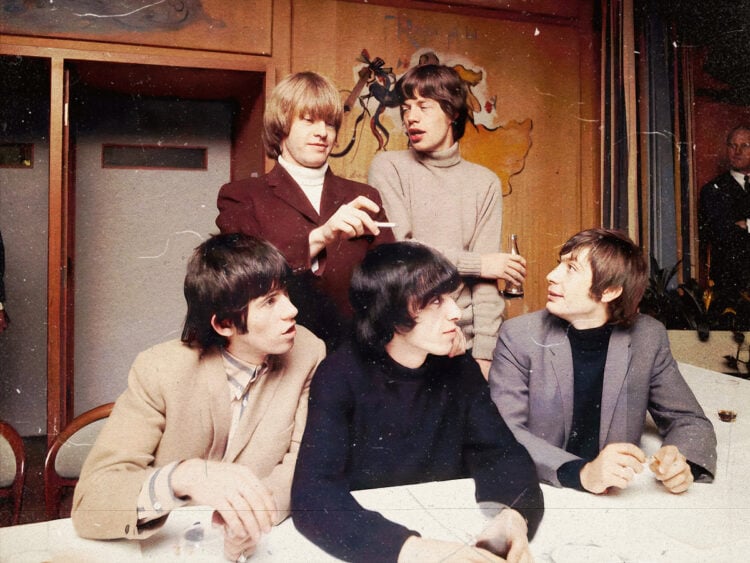Who has been in The Rolling Stones?
It isn’t even a stretch to declare The Rolling Stones the biggest rock and roll band of all time. Ever since their breakout in the mid-1960s, the band soared to a dizzying height that no act before them had ever reached and may never again. With no end of timeless hits that are written into the history books, the band’s members sit at the top of the musical food chain even as the lineup has chopped and changed.
While Mick Jagger, Keith Richards and Ronnie Wood stand as the band’s most notable and recognised members currently, the band have had a few additions come and go. Sadly, death has plagued the band. In 2021, their drummer, Charlie Watts, passed away after giving over 50 years to the band. Similarly, their original lead guitarist, Brian Jones, infamously passed away in 1969, right as the band broke through.
Beyond those best-known names, the group has had several other members during their over five-decade-long existence. After starting in 1963 and still touring regularly today, the band’s endurance is one for the history books. Moving through different eras, sounds, and styles as the years went on, it’s a wonder that there haven’t been more lineup changes.
The friendships and tensions within the band have chopped and changed, too. Keith Richards and Mick Jagger have made no secret of the fact that, for a while, their friendship was dead in the water. It even led to a brief walkout from Richards, but luckily, the guitarist returned and stands as one of the longest-lasting members.
Who are the members of The Rolling Stones?
Mick Jagger
It’s hard to think of another musician as famous as Mick Jagger. Everything about the singer is held up as a gold standard in music history, from his sound to his swagger. It was Jagger who started the band after becoming friends with Keith Richards in school and starting rehearsing in his garage with another musician called Dick Taylor.
At first, the group just played covers of their favourite blues and rock tracks, with Jagger leading the way on vocals. But considering his effortless and bright star power, it felt like it was only a matter of time before the frontman became world famous. As soon as the group started performing shows and writing their own material, that rare quality was quickly noticed and platformed as more and more people wanted to come see the handsome band leader in action.
Keith Richards
If Mick Jagger is the band’s captain, Keith Richards has always been his right-hand man and second in command. The pair met at school, quickly bonding over their mutual taste in music and love of American blues and rock musicians. Ever since those school days in 1950, the friends have proved inseparable as one of the most successful musical duos in history. As the band’s two songwriters, Richards and Jagger are responsible for some of the biggest songs of all time, with the guitarist standing as a songwriter on ‘Start Me Up’, ‘Gimme Shelter’, ‘Jumpin Jack Flash’ and beyond.
There was a brief blip in the mid-1980s when Richards stepped away from the group and didn’t tour with the group while focussing on solo projects. However, he didn’t stay away long. Even when tensions between Jagger and Richards have hit all-time highs, they’re brothers, with Richards stating, “I think of our differences as a family squabble.”
Ronnie Wood
Ronnie Wood was a later addition to the band but no less vital. The guitarist joined in 1975 after building a strong CV, performing as part of the Small Faces and the Jeff Beck Group. Wood became friends with Richards through their mutual circle, and when he came to record his first solo album, I’ve Got My Own Album to Do, he called in a favour from the Rolling Stone guitarist to play some parts. Wood’s musical chops were clearly impressed, as a year later, he got a call asking him to join the band to replace Mick Taylor. At first, Wood was just brought in to help with the Black and Blue sessions, but he quickly became too valuable to lose.
Wood plays slide guitar, just as Brian Jones had. He can also seamlessly switch between rhythm and lead guitar even in the same song, meaning that as a new addition, he could really be placed wherever the band needed him. Alongside Richards, the pair made a fierce guitar team.
Who are the past members of The Rolling Stones?
Charlie Watts
When Watts sadly passed away in 2021, the level of love and admiration held for him was seemingly limitless. Joining the group right at its infancy after meeting Mick Jagger through the London jazz and blues scene, he was perhaps the band’s most enduring and fuss-free member. While the rest of the members had a history of fall-outs, fights and dramatic personal lives, Watts always seemed focused on the task at hand and simply determined to do his job and do it well. That’s why he’s considered one of the most distinctive and influential drummers of all time.
Nicknamed the “Wembley Whammer”, Watts held the band together from his position behind the drum kit. In many ways, he was their humble leader as one of the longest-running members who played on every album up until his death.
Brian Jones
Brian Jones’ history with the group is a sad tale of hedonism gone too far. In 1963, he was a founding member of the band alongside Mick Jagger and Keith Richards, but his band members quickly took control of its direction as they began writing together.
At the start of their history, Jones was a vital member as a gifted multi-instrumentalist who contributed electric, acoustic and slide guitars, sitar, piano and even saxophone occasionally. However, as Jones’ drug intake worsened, he became utterly unreliable until he was kicked out of the band he started in 1969 and replaced by Mick Taylor. Later that year, he sadly died.
Mick Taylor
Taylor is one of the best-known past members of the band. In 1969, when Brian Jones became utterly useless to the group, Taylor was recommended by another of the band’s early members, Ian Stewart. At first, he was just called in to be a session musician but quickly impressed Richards and Jagger, leading him to stay in the group until 1974. Taylor first played on Let It Bleed as the band got him to overdub some of Jones’ guitar parts on ‘Honky Tonk Woman’. He made his on-stage debut with the band at their now iconic 1969 Hyde Park concert that ended up serving as a kind of memorial for Jones.
Taylor appears as a kind of saviour to the group. Not only did he come in and help them once Brian Jones was no longer playing, but in the early 1970s, he took over more of Keith Richards’ parts when his drug use got the better of them. In 2012, he returned to the band for a few more years of touring together to celebrate their 50th anniversary before leaving again in 2014.
Bill Wyman
Bill Wyman is all too often forgotten despite being one of the most enduring band members beyond the Stones’ core lineup. He was another one of their original players who joined in 1962 as the group got underway. He played bass guitar, making him the group’s only ever stable bassist in the lineup. He was also the oldest member of the band and seemed to serve as a mentor figure, corralling the younger members into practice rooms. He was also a close friend of Brian Jones, being one of only two band members to attend his funeral along with Charlie Watts.
Wyman plays on the band’s first 19 albums, providing a huge contribution. He left in 1993 for no real reason beyond feeling like he’d done his time and made his money. There was, however, the suggestion that he had always felt ignored by Jagger and not considered a real member of the band in comparison to Richards, Watts or later Wood.
Ian Stewart
Ian Stewart was one of the group’s earliest but shortest-running members. He joined in 1962 as the band formed. Back then, the band was involved in the London blues and jazz scene, so it seemed to make sense to have a keyboard player. Richards described Stewart’s style as “boogie-woogie piano”, but while his musical impact might not have been all that large on the band, he played an important role in the early days simply by being the only member with a desk job and a phone.
He said, “[My] desk at ICI was the headquarters of the Stones organisation. My number was advertised in Jazz News and I handled the Stones’ bookings at work.”






